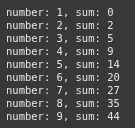Python While Loops
We are going to be looking at the While loop in python.
The while loop in python is a control flow statement that repeatedly executes a block of code as long as a specified condition is true.
Example 1 Basic While Loop
Here, we are using the while loop to print numberd from 1 to 9.
It keeps increasing x by 1 until it reaches 10.
x = 1
while x < 10:
print(x)
x = x + 1
Example 2 Basic While Loop
This loop prints the current number (x) and running sum in each iteration.
It adds the next x to sum after printing, repeating until x is 10.
x = 1
sum = 0
while x < 10:
print('number: ' + str(x) + ', sum: ' + str(sum))
x = x + 1
sum +=x

Example 1 - if else state location
This line of code creates an infinite loop because i starts at 2 and keeps increasing, so the condition i > 1 is always true.
i = 2
while i > 1:
print('infinite')
i = i + 1

Example 4 break and Continue
This while loop prints numbers from 1 to 4. When x reaches 5, the break statement exits the loop early.
x = 1
while x < 10:
if x == 5:
break
print(x)
x = x + 1
This loop prints numbers from 1 to 9, but skips 5. when x is 5, “continue” skips the print() and goes to the next iteration
x = 1
while x < 10:
if x == 5:
x = x + 1
continue
print(x)
x = x + 1
Example 5 While Loops with inputs
Here, we keep asking the user for a number, square it, and print the result. It stop when the user enters ‘z’. Inputs are cast to integers before squaring.
while True:
x = input("Enter Number ")
if x == 'z':
break
print (int(x) * int(x)) #need to cast as int

Example 5b variant While Loops with inputs
Here, we ask the user for a positive number less than 20. If the input is invalid, it keeps prompting until valid.
Then it prints the square of the number.
x = input("Enter positive Number less than 20 ")
while int(x) < 0 or int(x) > 20:
print("Wrong Number")
x = input("Enter positive Number less than 20 ")
print (int(x) * int(x)) #need to cast as int
Example 6 lists
Here we loop through the list and add each positive number to sum, stopping if it reaches the end or encounters a non-positive number.
It prints the runnung total after each addition.
list = [1, 3, 7, 11, 6, 8, 10]
sum = 0
x = 0
while x < len(list) and list[x] > 0:
sum += list[x]
x +=1
print(sum)
Example 6b lists
This code iterates through the list, and for each element at a positive index, it adds the value to even_sum if thr index is even, or to odd_sum if the index is odd.
list = [1, 3, 7, 11, 6, 8, 10]
even_sum = 0
odd_sum = 0
x = 0
while x < len(list) and list[x] > 0:
if x % 2 == 0:
even_sum += list[x]
else:
odd_sum += list[x]
x +=1
even_sum
odd_sum
Example 7 multiple
Here we use a nested loop to print a multiplication table for numbers 2 through 8, each multiplied by 1 through 3.
# Initialize variables
x = 2
# Outer while loop
while x <= 8:
y = 1
# Inner while loop
while y <= 3:
# Perform calculation using both x and y
result = x * y
# Print the result
print(f"{x} * {y} = {result}")
# Increment y
y += 1
# Increment x
x += 1

Ryan is a Data Scientist at a fintech company, where he focuses on fraud prevention in underwriting and risk. Before that, he worked as a Data Analyst at a tax software company. He holds a degree in Electrical Engineering from UCF.
